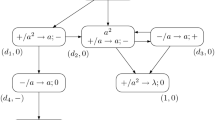Abstract
Spiking neural (SN) P systems are a class of distributed parallel computing devices inspired by the way neurons communicate by means of spikes. In this work, we investigate reversibility in SN P systems, as well as the computing power of reversible SN P systems. Reversible SN P systems are proved to have Turing creativity, that is, they can compute any recursively enumerable set of non-negative integers by simulating universal reversible register machine.
Similar content being viewed by others
References
Landauer R. Irreversibility and heat generation in the computing process. IBM Journal of Research and Development, 1961, 5(3): 183–191
Von Neumann J. Theory of self-reproducing automata. University of Illinois Press, 1966
Bennett C. Logical reversibility of computation. IBM Journal of Research and Development, 1973, 17(6): 525–532
Morita K, Yamaguchi Y. A universal reversible turing machine. In: Proceedings of the 5th International Conference on Machines, Computations, and Universality. 2007, 90-98
Priese L. On a simple combinatorial structure sufficient for sublying nontrival self-reproduction. Journal of Cybernetics, 1976, 6: 101–137
Fredkin E, Toffoli T. Conservative logic. International Journal of The oretical Physics, 1982, 21(3): 219–253
Toffoli T, Margolus N. Invertible cellular automata: a review. Physica D: Nonlinear Phenomena, 1990, 45(1): 229–253
Morita K. Universality of a reversible two-counter machine. Theoretical Computer Science, 1996, 168(2): 303–320
Leporati A, Zandron C, Mauri G. Reversible P systems to simulate fredkin circuits. Fundamenta Informaticae, 2006, 74(4): 529–548
Alhazov A, Morita K. On reversibility and determinism in p systems. In: Proceedings of the 10th International Conference on Membrane Computing. 2009, 158–168
Păun G. Computing with membranes. Journal of Computer and System Sciences, 2000, 61(1): 108–143
Ionescu M, Páun G, Yokomori T. Spiking neural P systems. Fundamenta informaticae, 2006, 71(2): 279–308
Păun G, MARIO J, Rozenberg G. Spike trains in spiking neural P systems. International Journal of Foundations of Computer Science, 2006, 17(4): 975–1002
Chen H, Freund R, Ionescu M, Páun G, Pérez-Jiménez M. On string languages generated by spiking neural P systems. Fundamenta Informaticae, 2007, 75(1): 141–162
Zhang X, Zeng X, Pan L. On string languages generated by spiking neural P systems with exhaustive use of rules. Natural Computing, 2008, 7(4): 535–549
Păun A, Păun G. Small universal spiking neural P systems. BioSystems, 2007, 90(1): 48–60
Pan L, Zeng X. Small universal spiking neural P systems working in exhaustive mode. IEEE Transactions on NanoBioscience, 2011, 10(2): 99–105
Ishdorj T, Leporati A, Pan L, Zeng X, Zhang X. Deterministic solutions to QSAT and Q3SAT by spiking neural P systems with precomputed resources. Theoretical Computer Science, 2010, 411(25): 2345–2358
Pan L, Păun G, Pérez-Jiménez M. Spiking neural P systems with neuron division and budding. Science China Information Sciences, 2011, 54(8): 1596–1607
Zeng X, Zhang X, Pan L. Homogeneous spiking neural P systems. Fundamenta Informaticae, 2009, 97(1): 275–294
Wang J, Hoogeboom H, Pan L, Paun G, Pérez-Jiménez M. Spiking neural P systems with weights. Neural Computation, 2010, 22(10): 2615–2646
Pan L, Zeng X, Zhang X. Time-free spiking neural P systems. Neural Computation, 2011, 23(5): 1320–1342
Pan L, Wang J, Hoogeboom H. Spiking neural P systems with astrocytes. Neural Computation, 2012, 24(3): 805–825
Rozenberg G. Handbook of formal languages: word, language, grammar. Springer Verlag, 1997
Păun G. Membrane computing: an introduction. Fundamentals of Computation Theory, 2003, 177–220
Author information
Authors and Affiliations
Corresponding author
Additional information
Tao Song received his BS and MS in Applied Mathematics from Qingdao University in 2006 and Shandong University of Science and Technology, China in 2009, respectively. He is recently a PhD candidate at Huazhong University of Science and Technology. His research interests include DNA computing, DNA encoding, and membrane computing
Xiaolong Shi received his PHD from Huazhong University of Science and Technology (HUST), China, in 2004. He is currently an associate professor in the Department of Control Science and Engineering of HUST. His research interests include DNA nanotechnology, pattern recognition, and intelligent and bio-inspired computing.
Jinbang Xu received his PhD in Control Science and Engineering from Huazhong University of Science and Technology (HUST), in 2004. He is currently an associate professor in Department of Control science and Engineering of HUST. His current research interests include power electronic and bioinformatics processing.
Rights and permissions
About this article
Cite this article
Song, T., Shi, X. & Xu, J. Reversible spiking neural P systems. Front. Comput. Sci. 7, 350–358 (2013). https://doi.org/10.1007/s11704-013-2061-2
Received:
Accepted:
Published:
Issue Date:
DOI: https://doi.org/10.1007/s11704-013-2061-2




